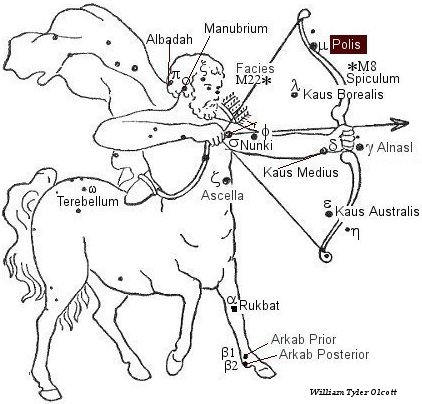| Fixed star: POLIS | |
| Constellation: Mu (μ) Sagittarius | |
| Longitude 1900: 01CAP49 | Longitude 2000: 03CAP13 |
| Declination 1900: -21.05′ | Declination 2000: -21.03′ |
| Right ascension: 18h 13m | Latitude: +02.20′ |
| Spectral class: B8 | Magnitude: 3.0 Variable |
The history of the star: Polis
from p.359 of Star Names, Richard Hinckley Allen, 1889.
[A scanned copy can be viewed on this webpage

They mark the point of the winter solstice two thirds of the way southward towards, and in line with, the cluster N.G.C. (New Galaxy Catalog) 6523, 8 M., visible to the naked eye, with other noticeable clusters and nebulae close by. One of these, N.G.C. 6603, 24 M., towards the northeast, is Secchi’s Delle Caustiche, from its peculiar arrangement of curves, while the celebrated Trifid Nebula, N.G.C. (New Galaxy Catalog) 6514, 20 M., lies not far off to the southwest.
Brown says that the stars in the bow were the Persian Gau and the Sogdian Iranian and Khorasmian (east of Persia) Yaugh, but by these nations were imagined as a Bull; the Copts (who are now the Christians in Egypt) knew them as Polis, a Foal.
This star Polis, with lambda (Kaus Borealis) (the stars in the northern part of the Bow), were the Arabic Ra’i al Na’aim, the “Keeper of the Na’ams”. In ancient Arabia the two small groups of stars now marking the head and the vane of the Archer’s arrow were of much note as relics of still earlier asterisms, as well as a lunar station. The westernmost of these, — gamma (Alnasl), delta (Kaus Medius), epsilon (Kaus Australis), and eta — were Al Na’am al Warid, the Going Ostriches; and the easternmost, — sigma (Nunki), zeta (Ascella), phi, chi, and tau, — Al Na’am al Sadirah, the Returning Ostriches, passing to and from the celestial river, the Milky Way, with lambda (Kaus Borealis) and these stars mu and mu ( this star Polis), as their Keeper; Ra’i al Na’aim, the “Keeper of the Na’ams”, or Al Thalimain, meaning desert birds.
Star Names, Their Lore and Meaning, Richard Hinckley Allen, 1889].
The astrological influences of the constellation Sagittarius
The following are Ptolemy’s remarks: “The stars at the point of the arrow in Sagittarius have influence similar to that of Mars and the Moon: those on the bow, and at the grasp of the hand, act like Jupiter and Mars . . . those in the waist and in the back resemble Jupiter, and also Mercury moderately: those in the feet, Jupiter and Saturn.” … By the Kabalists Sagittarius is associated with the Hebrew letter Vau and the 6th Tarot Trump “The Lovers.” [Robson, p.60.]
The astrological influences of the constellation Sagittarius given by Manilius:
“As for the Archer, when the foremost portion of his cloak rises, he will give birth to hearts renowned in war and will conduct the conqueror, celebrating great triumphs in the sight of all, to his country’s citadels. Such a one will build high walls (moenia from Latin murus) one moment and pull them down the next. But if Fortune favours them too generously with success, the mark of her envy is to be seen on their faces, for she works cruel havoc upon their features. So was it that a dread warrior paid for his victories at the Trebia, Cannae, and the Lake, even before the hour of his retreat, with such disfigurement.” [Translator’s note: *Hanibal who lost an eye (Livy 22.2.11: Sagittarius is one-eyed; see p.103] [Manilius, Astronomica, 1st century AD, book 4, p.267]
“But they whose lot it is to be born under the Centaur of double form delight in yoking a team, in bringing a fiery horse to obey the pliant reins, in following herds which graze all over the grasslands, and in imposing a master on every kind of quadruped and taming them: they soften tigers, rid the lion of his fierceness, speak to the elephant and through speech adapt its huge bulk to human skills in a variety of displays. Indeed, in the stars of this constellation the human form is blended with a beast’s and placed above it; wherefore it has lordship over beasts. And because it carries a shaft poised on drawn bow, it imparts strength to limb and keenness to the intellect, swiftness of movement, and an indefatigable spirit.” [Manilius, Astronomica, 1st century AD, book 4, p.241.]
The astrological influences of the star Polis
Notes: A triple star in the upper part of the bow of Sagittarius. From the Coptic Polis, a Foal.
Influence: Of the nature of Jupiter and Mars. It gives success, high ambition, martial desires, horsemanship, keen perception and domination. [Robson, p.185.]
Polis is a fortunate star portending success, ambition and truthfulness. [Fixed Stars and Judicial Astrology, George Noonan, 1990, p.36].
This Jupiter-Mars star shows up in a horoscope with almost the regal qualities of mighty Regulus. Only this star, Polis will indicate more of the high office in spiritual life, Pope, Iman, Archbishop, or at least a prominent Theologian, than in the temporal world of kings and statesmen. Unfavorably aspected, however, it may show more the self-styled pretender to dignity, or the one who on gaining appointment fails to meet expectations. If better aspected, but not aided by Sun or 10th, say, then we still have someone whose interest and knowledge of things spiritual may be both keen and profound. [The Living Stars, Dr. Eric Morse, p.93,94.]
References:
Fixed Stars and Constellations in Astrology, Vivian E. Robson, 1923].